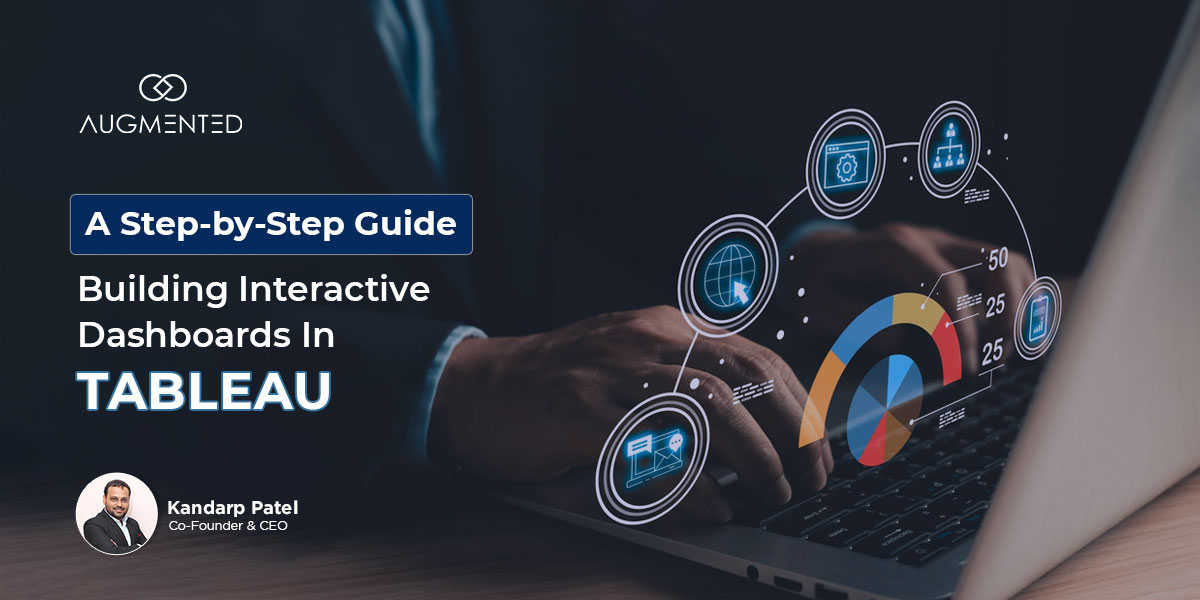Here’s something I hear all the time: “I opened Tableau…and then closed it five minutes later.”
Totally fair.
It’s one of many powerful and commonly used data visualization tools, which can be confusing at first glance.
So many buttons.
So many options.
The interface.
The terminology.
The charts.
What does “drag a field here” even mean? Plus, let’s not forget the data you have spread across different formats and platforms.
To be honest, most marketers, sales teams, analysts, and even founders don’t really know what to do with their data, let alone understand it.
And that’s exactly why I’ve created this guide.
Sure, it can be a little intimidating for first-timers. But once you know what you’re doing, using Tableau is actually a great source for business intelligence and actionable insights!
It makes messy spreadsheets visual, interactive, and (dare I say) exciting!
So, in this guide, I’ve covered:
- What is Tableau, and Why You Should Use It
- How to use Tableau: A Step-by-Step Guide
- And a few of my personal Tableau best practices
(P.S.: If you’re someone who has been waiting to “get” Tableau but didn’t know where to start, this is especially for you!)
Let’s get started.
How to Use Tableau? Table of Contents
- What is Tableau?
- How do You Use Tableau Step by Step for the First Time?
- What are Tableau’s Best Practices?
- Is Tableau the Best Tool For Your Business?
- How to Use Tableau? FAQS
What is Tableau?
Before we dive into how to use Tableau, let’s first understand what it is and why you should use it.
Founded in 2003 and now part of Salesforce, Tableau is one of the leading data visualization tools available today.
It’s trusted by businesses of all sizes to turn their large chunks of raw data into clean, interactive dashboards that are easy to explore and even easier to present!
Now, think about working in Excel for a second:
You’re juggling between rows and columns, copy-pasting data from different resources, writing complex formulas, and hoping that those pivot tables will not break.
Not a very good feeling, right?
And in my experience, that’s one of the biggest benefits of Tableau over Excel:
While Excel relies on manual input and formulas, Tableau lets you drag, drop, and visualize your data in real-time from different sources, such as Excel Spreadsheets and Cloud Platforms like Google Analytics.
Once you have all your data in one place, Tableau lets you analyze it visually through charts, graphs, maps, and dashboards.
Which brings us to the next question:
Why Use Tableau?
Did you know that as of 2024, Tableau is used by over 86,000 organizations worldwide, including giants like Amazon, Deloitte and Unilever?
So, why do so many businesses rely on it? Because it helps you quickly understand what’s happening in your business. You can track KPIs, spot trends, compare regions, and get actionable insights within minutes.
Some other benefits include:
- It’s beginner-friendly with an intuitive drag-and-drop interface
- Connects seamlessly with 100s of data sources
- Updates your dashboards in real time
- Enables rich storytelling visuals, maps, and charts
- Scales easily across teams and departments
So, depending on your roles and business goals, you can use Tableau in many different ways.
Okay, so you might be convinced that Tableau could help you clearly understand your business processes and operations:
How do you actually use Tableau? What does the process look like?
So, without further ado, let’s get into it.
How do You Use Tableau Step by Step for the First Time?
If you ask me, the best part of Tableau is how naturally it flows.
It’s as simple as this:
- Connect your data
- Drag and drop the fields you want to analyze
- Instantly see the patterns come to life on your screen
So, let’s walk through each step, right from installing Tableau to building your very first interactive dashboard.
(P.S.: Think of this as your hands-on Tableau dashboard tutorial. By the end of this guide, you’ll know how it flows naturally and lets you go from raw datasets to clean and actionable dashboards.)
Here’s how it works:
Step 1: Install Tableau
The first step to harnessing the power of Tableau is to complete the initial setup. You’ve two beginner-friendly options:
- Tableau Desktop: Paid version, but comes with a 14-day trial
- Tableau Public: Completely free, but your dashboard will be public
How to Install Tableau:
1. Go to Tableau’s official website
Here’s what it looks like:
2. Choose Tableau Public or Desktop, depending on your preferences; again, you should see something like this:
3. Download and run the installer
4. Follow the on-screen instructions to install Tableau on your computer
Once installed, simply launch the Tableau application!
And with that, you’re ready to start creating your customized dashboards!
Step 2: Connect Tableau to Your Data
Now that you’ve downloaded and installed Tableau, it’s time to bring in your data.
As we’ve already discussed, Tableau's best feature is its ability to easily connect to various data sources, such as Google Sheets, Excel, Cloud platforms, and more.
How to Connect Your Data with Tableau:
- In Tableau, look for the “Connect” pane on the start screen
- Select your data source (like Microsoft Excel)
- Find and select the file you want to work with
- Click “Open” or “Connect”
Now, you’ll see a preview of your datasets, like rows, columns, or fields, before you start working with them.
Here’s what it could look like:
Step 3: Clean and Prepare Your Data
In my experience, cleaning your data before using it to create charts and graphs can help you a lot in the long run. Trust me, taking the time to clean your data upfront will save you from a lot of headaches and inconsistencies down the line.
How to Clean Your Data For Tableau:
- Remove unnecessary columns
- Rename confusing headers (double click to edit)
- Check for empty or null values (remove or replace the null values if you find them)
- Group similar values if necessary (e.g., New York City, NYC)
Tableau makes this part easy with a drag-and-drop interface in the Data Pane. So, you can make changes in your data by dragging and dropping fields, applying filters, or creating calculated fields. And all of this without writing any codes.
Step 4: Start Building Your Visualizations
Finally, we get to the fun and insightful part of using Tableau:
Clean, clear and concise data visualization.
How to Visualize Your Data With Tableau:
- Click on “Sheet 1” at the bottom
- Drag a dimension (like Region) into the rows shelf
- Drag a measure (like sales) into the column's shelf
And, within the blink of an eye, Tableau auto-generates a bar chart for you. (Seriously, go try it yourself. It’s that easy!)
Step 5: Create a Dashboard
By following the steps we’ve outlined above, you can create various charts, graphs, and visualizations. Now it’s time to ‘bring them all together under a common cluster’, through a dashboard.
How to Create a Tableau Dashboard for Data Visualizations:
- Click the “Dashboard” tab at the bottom (Next to Sheet 1)
- A blank canvas appears
- On the left, drag your sheets one by one into the dashboard area
- Add filters, legends, and dropdowns to make it interactive
- Resize and arrange your charts so everything looks clean and tells a clear story
Pro Tip: Use “Containers” to group related charts and keep everything aligned under a suitable tag.
Step 6: Share Your Insights
Now that you’ve built something you’re proud of. It’s time you share it with your team members and other stakeholders.
How to Share Your Data Visualizations Using Tableau:
- Export as a PDF or image if you want a snapshot
- Publish to Tableau Public, great for portfolios, but remember that your data will be public
- Use Tableau Server or Tableau Cloud to securely share insights with your team
Alternatively, you can also share an entire Tableau dashboard with your colleagues, teams, or fellow executives:
How to Share Tableau Dashboards:
- Click “File” > “Save to Tableau Public” (Or Server/Cloud)
- You’ll be asked to sign in or create an account
- Once published, you’ll get a link you can share
And just like that, you’ve created detailed, highly impactful visualizations and shared them with your team!
Tableau doesn’t ask you to write codes or memorize complex formulas. You just point, click, drag, and drop!
I’m pretty sure that even if you are brand new to data tools, you’ll pick this up in minutes.
How to Get the Most Out of Tableau: Best Practices
When you’re starting out with Tableau (or even if you’ve been using it for a while), it’s easy to get caught up in all the features, which could lead you to:
- Lose sight of what’s truly important
- Get overwhelmed by the different functionalities
- Miss out on the best features
- Struggle to identify which features best suit your process
- Even reconsider leaving Tableau altogether!
But as one of the most powerful data visualization tools out there, Tableau shines best when you follow a set of free, practical habits that keep your dashboards clean, useful and impactful.
Here are some Tableau best practices I personally follow. And trust me, they’ve made a big difference in how my dashboards are received:
- Keep your data clean and visuals focused
- Label your charts, graphs, axes, labels, filters, and other elements clearly
- Use colors wisely, like contrasting colors, for sharper insights
- Test interactivity before you share
- Try to create a story for your data visualizations
Following these Tableau best practices will help you build dashboards that don’t just look good but actually help you make real business decisions.
Is Tableau the Best Tool for Your Business?
So, is Tableau the best BI tool? I’d leave that decision to you!
In my experience, it usually depends on what you need. Simply put, Tableau’s effectiveness depends on how you use it and whether or not it fits your team’s needs and workflows!
For instance, if flexibility, real-time insights, and stunning dashboards are important to you, Tableau might be the perfect data visualization tool for your requirements.
And if you’re still unsure where to start or how to harness Tableau’s full capabilities, we can help!
At Augmented Systems, we specialize in empowering enterprises to build customized dashboards that identify problems and drive solutions.
So, if you’re looking to leverage the power of business intelligence through Tableau, connect with us for a free consultation and unlock a world of possibilities!
How to Use Tableau: FAQs
1. Is Tableau easy to learn?
Yes. Tableau is extremely easy to learn, especially if you’re just starting out with data analytics. Its drag-and-drop interface, interactive visuals, and built-in tutorials make it one of the most user-friendly data visualization tools available today.
2. Is Tableau easier than Excel?
In my experience, Tableau is easier than Excel for data visualizations. While Excel is great for calculations and small datasets, Tableau is great for working with large, complex datasets.
3. Do I need coding for Tableau?
No, you don’t need coding to use Tableau. However, some basic knowledge of formulas or SQL can enhance what you can do to create dashboards.
4. Can I learn Tableau in one week?
Yes, you can learn the basics of Tableau in one week, which I think would be enough to build simple dashboards and understand its key features. With consistent practice and by following a good Tableau dashboard tutorial, you can get started very quickly.




